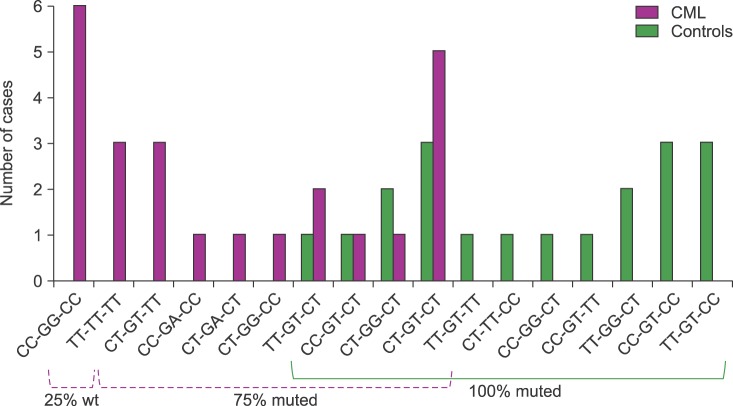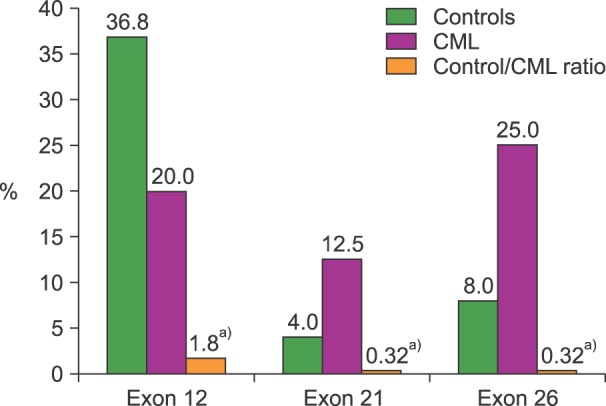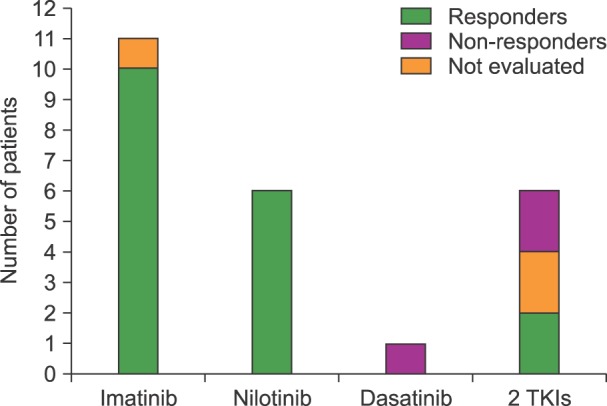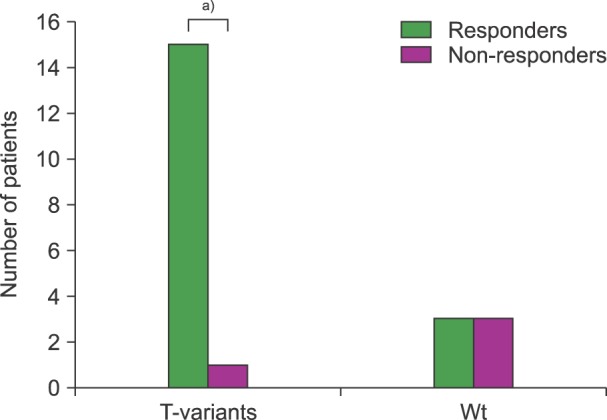Blood Res.
2015 Sep;50(3):154-159. 10.5045/br.2015.50.3.154.
MDR1/ABCB1 gene polymorphisms in patients with chronic myeloid leukemia
- Affiliations
-
- 1INFIBIOC-FFyB-UBA, Buenos Aires, Argentina. nadiatom@ffyb.uba.ar
- 2Division Gastroenterologia Hospital de Clinicas "J. San Martin", Buenos Aires, Argentina.
- 3Division Hematologia, Hospital Municipal "Ramos Mejia", Buenos Aires, Argentina.
- 4Division Hematologia, Hospital de Clinicas "J. San Martin", Facultad de Medicina-UBA, Buenos Aires, Argentina.
- 5Division Hemoterapia, Hospital de Clinicas "J. San Martin", Facultad de Medicina-UBA, Buenos Aires, Argentina.
- 6Fundacion Investigar, Buenos Aires, Argentina.
- KMID: 2172758
- DOI: http://doi.org/10.5045/br.2015.50.3.154
Abstract
- BACKGROUND
Tyrosine kinase inhibitors (TKIs) are the recommended treatment for patients with chronic myeloid leukemia (CML). The MDR1/ABCB1 gene plays a role in resistance to a wide spectrum of drugs, including TKIs. However, the association of MDR1/ABCB1 gene polymorphisms (SNPs) such as C1236T, G2677T/A, and C3435T with the clinical therapeutic evolution of CML has been poorly studied. We investigated these gene polymorphisms in CML-patients treated with imatinib, nilotinib and/or dasatinib.
METHODS
ABCB1-SNPs were studied in 22 CML-patients in the chronic phase (CP) and 2 CML-patients in blast crisis (BC), all of whom were treated with TKIs, and compared with 25 healthy controls using nested-PCR and sequencing techniques.
RESULTS
Seventeen different haplotypes were identified: 7 only in controls, 6 only in CML-patients, and the remaining 4 in both groups. The distribution ratios of homozygous TT-variants present on each exon between controls and CML-patients were 2.9 for exon 12, and 0.32 for the other 2 exons. Heterozygous T-variants were observed in all controls (100%) and 75% of CML-patients. Wt-haplotype (CC-GG-CC) was observed in 6 CML-patients (25%). In this wt-group, two were treated with nilotinib and reached a major molecular response. The remaining 4 cases had either a minimal or null molecular response, or developed bone marrow aplasia.
CONCLUSION
Our results suggest that SNPs of the MDR1/ABCB1 gene could help to characterize the prognosis and the clinical-therapeutic evolution of CML-patients treated with TKIs. Wt-haplotype could be associated with a higher risk of developing CML, and a worse clinical-therapeutic evolution.
MeSH Terms
Figure
Reference
-
1. Deininger MW, Goldman JM, Melo JV. The molecular biology of chronic myeloid leukemia. Blood. 2000; 96:3343–3356. PMID: 11071626.
Article2. Saglio G, Kim DW, Issaragrisil S, et al. Nilotinib versus imatinib for newly diagnosed chronic myeloid leukemia. N Engl J Med. 2010; 362:2251–2259. PMID: 20525993.
Article3. Goldman JM, Melo JV. Chronic myeloid leukemia-advances in biology and new approaches to treatment. N Engl J Med. 2003; 349:1451–1464. PMID: 14534339.4. Nagar B, Bornmann WG, Pellicena P, et al. Crystal structures of the kinase domain of c-Abl in complex with the small molecule inhibitors PD173955 and imatinib (STI-571). Cancer Res. 2002; 62:4236–4243. PMID: 12154025.5. Deininger M, Buchdunger E, Druker BJ. The development of imatinib as a therapeutic agent for chronic myeloid leukemia. Blood. 2005; 105:2640–2653. PMID: 15618470.
Article6. Druker BJ, Guilhot F, O'Brien SG, et al. Five-year follow-up of patients receiving imatinib for chronic myeloid leukemia. N Engl J Med. 2006; 355:2408–2417. PMID: 17151364.7. Hochhaus A, Kreil S, Corbin AS, et al. Molecular and chromosomal mechanisms of resistance to imatinib (STI571) therapy. Leukemia. 2002; 16:2190–2196. PMID: 12399961.
Article8. Deininger MW, Druker BJ. SRCircumventing imatinib resistance. Cancer Cell. 2004; 6:108–110. PMID: 15324693.
Article9. Baccarani M, Saglio G, Goldman J, et al. Evolving concepts in the management of chronic myeloid leukemia: recommendations from an expert panel on behalf of the European LeukemiaNet. Blood. 2006; 108:1809–1820. PMID: 16709930.
Article10. Khan KA, Junaid A, Siddiqui NS, Mukhtar K, Siddiqui S. Imatinib-related bone marrow aplasia after complete cytogenetic response in chronic myeloid leukemia. J Coll Physicians Surg Pak. 2008; 18:176–178. PMID: 18460249.11. Alabdulaaly A, Rifkind J, Solow H, Messner HA, Lipton JH. Rescue of interferon induced bone marrow aplasia in a patient with chronic myeloid leukemia by allogeneic bone marrow transplant. Leuk Lymphoma. 2004; 45:175–177. PMID: 15061216.
Article12. Henkes M, van der Kuip H, Aulitzky WE. Therapeutic options for chronic myeloid leukemia: focus on imatinib (Glivec, Gleevectrade mark). Ther Clin Risk Manag. 2008; 4:163–187. PMID: 18728706.13. Mahon FX, Hayette S, Lagarde V, et al. Evidence that resistance to nilotinib may be due to BCR-ABL, Pgp, or Src kinase overexpression. Cancer Res. 2008; 68:9809–9816. PMID: 19047160.
Article14. Shukla S, Sauna ZE, Ambudkar SV. Evidence for the interaction of imatinib at the transport-substrate site(s) of the multidrug-resistance-linked ABC drug transporters ABCB1 (P-glycoprotein) and ABCG2. Leukemia. 2008; 22:445–447. PMID: 17690695.
Article15. Tanabe M, Ieiri I, Nagata N, et al. Expression of P-glycoprotein in human placenta: relation to genetic polymorphism of the multidrug resistance (MDR)-1 gene. J Pharmacol Exp Ther. 2001; 297:1137–1143. PMID: 11356939.16. Gréen H, Söderkvist P, Rosenberg P, Horvath G, Peterson C. mdr-1 single nucleotide polymorphisms in ovarian cancer tissue: G2677T/A correlates with response to paclitaxel chemotherapy. Clin Cancer Res. 2006; 12:854–859. PMID: 16467099.
Article17. Marzolini C, Paus E, Buclin T, Kim RB. Polymorphisms in human MDR1 (P-glycoprotein): recent advances and clinical relevance. Clin Pharmacol Ther. 2004; 75:13–33. PMID: 14749689.
Article18. Riva A, Kohane IS. SNPper: retrieval and analysis of human SNPs. Bioinformatics. 2002; 18:1681–1685. PMID: 12490454.
Article19. Jamroziak K, Robak T. Pharmacogenomics of MDR1/ABCB1 gene: the influence on risk and clinical outcome of haematological malignancies. Hematology. 2004; 9:91–105. PMID: 15203864.20. Dulucq S, Bouchet S, Turcq B, et al. Multidrug resistance gene (MDR1) polymorphisms are associated with major molecular responses to standard-dose imatinib in chronic myeloid leukemia. Blood. 2008; 112:2024–2027. PMID: 18524988.
Article21. Maffioli M, Camós M, Gaya A, et al. Correlation between genetic polymorphisms of the hOCT1 and MDR1 genes and the response to imatinib in patients newly diagnosed with chronic-phase chronic myeloid leukemia. Leuk Res. 2011; 35:1014–1019. PMID: 21185600.
Article22. Angelini S, Soverini S, Ravegnini G, et al. Association between imatinib transporters and metabolizing enzymes genotype and response in newly diagnosed chronic myeloid leukemia patients receiving imatinib therapy. Haematologica. 2013; 98:193–200. PMID: 22875622.
Article23. Jaffe ES, Harris NL, Stein H, Vardiman JW, editors. WHO Classification of tumours. pathology and genetics of tumours of haematopoietic and lymphoid tissues. Lyon, France: IARC Press;2001. p. 20–26.24. Baccarani M, Cortes J, Pane F, et al. Chronic myeloid leukemia: an update of concepts and management recommendations of European LeukemiaNet. J Clin Oncol. 2009; 27:6041–6051. PMID: 19884523.
Article25. Ni LN, Li JY, Miao KR, et al. Multidrug resistance gene (MDR1) polymorphisms correlate with imatinib response in chronic myeloid leukemia. Med Oncol. 2011; 28:265–269. PMID: 20204543.
Article26. Illmer T, Schuler US, Thiede C, et al. MDR1 gene polymorphisms affect therapy outcome in acute myeloid leukemia patients. Cancer Res. 2002; 62:4955–4962. PMID: 12208746.27. Hoffmeyer S, Burk O, von Richter O, et al. Functional polymorphisms of the human multidrug-resistance gene: multiple sequence variations and correlation of one allele with P-glycoprotein expression and activity in vivo. Proc Natl Acad Sci U S A. 2000; 97:3473–3478. PMID: 10716719.
Article28. Berger U, Maywald O, Pfirrmann M, et al. Gender aspects in chronic myeloid leukemia: long-term results from randomized studies. Leukemia. 2005; 19:984–989. PMID: 15830009.
Article29. Baccarani M, Deininger MW, Rosti G, et al. European LeukemiaNet recommendations for the management of chronic myeloid leukemia: 2013. Blood. 2013; 122:872–884. PMID: 23803709.
- Full Text Links
- Actions
-
Cited
- CITED
-
- Close
- Share
- Similar articles
-
- Multi-drug resistance (MDR1) gene expression in de novo acute leukemia cells: correlations with CD surface markers and treatment outcome
- ABCB1 and BMI1 mRNA expression in patients with chronic myeloid leukemia: impact on imatinib efficacy
- A Case of Leukemia Cutis in Myelodysplastic Syndrome Evolving into An Atypical Chronic Myeloid Leukemia
- OCT-1, ABCB1, and ABCG2 Expression in Imatinib-Resistant Chronic Myeloid Leukemia Treated with Dasatinib or Nilotinib
- Expression of Multidrug Resistance Protein 1 in Human Hepatocellular Carcinoma





